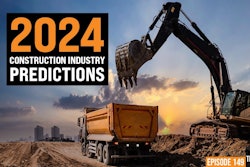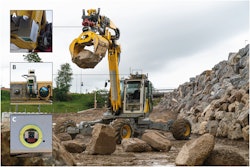Will construction continue to remain strong in 2024 amid economic uncertainties?
Ken Simonson, chief economist for the Associated General Contractor of America, says, “I’m not using the ‘r’ word, but I do think a slowdown is likely.”
On this episode of The Dirt, Simonson explains his cautious outlook, pointing to a variety of headwinds that will likely lead to disparities in growth by industry sector.
“There will be a lot of opportunities in categories like manufacturing, data centers, and hopefully, finally getting some more infrastructure money out of the federal government,” says Simonson. “I think that’s going to outweigh declines in multi-family and developer-financed non-residential categories.”
He also gives his take on labor productivity, wage growth, inflation and interest rates, saying it will lead to “a lot of change” for construction.
His interview with host Bryan Furnace is a must-view for anyone in the construction industry concerned about the future and what moves they should be considering now.
So check out the latest episode of The Dirt to see what you can expect in 2024 and beyond.
Equipment World serves up weekly videos on the latest in construction equipment, work trucks and pickup trucks – everything contractors need to get their work done. Subscribe and visit us at equipmentworld.com!
00:00 - 2023 Economy vs 2024 Economy
00:29 - 2023 Economy: What Happened?
01:40 - 2024 Economic Predictions
03:54 - Will Prices Continue to Increase in 2024?
06:17 - 2024 Supply Chain Predictions
09:40 - Federal Interest Rate: How Does It Help Inflation?
14:52 - Biggest Opportunities in 2024
15:41 - Final Thoughts
Bryan Furnace (00:00):
This EquipmentWorld video is brought to you by Chevron Delo 600 ADF Ultra Low Ash Diesel Engine Oil. It's time to kick some ash.
(00:09):
Today, we're back for another economic update. It is the end of 2023. What did we just experience and what do we have to look forward to next year when it comes to the state of the economy? Back with us is our favorite economist, Ken Simonson, to tell us what to expect.
(00:29):
To begin with, can we kind of just recap 2023, kind of what we went through and then how you see that kind of moving into 2024 and what the changes are going to look like?
Ken Simonson (00:38):
Sure. If we can roll back the film a year, a lot of people thought we were already in recession or certainly on the verge of one, and that sure didn't happen. Adding jobs every month at a substantially higher rate than most forecasters expected, and inflation has been coming down at a good pace.
(00:57):
Now, that doesn't mean that everything is hunky-dory. Certainly we saw a big jump in interest rates and that was squeezing out developers, but by and large, non-residential construction did very well. Multifamily construction remains strong, and there were only a few weak spots.
Bryan Furnace (01:14):
It's so interesting to kind of have our boots on the ground, take on everything and then hear you come in at the 30,000-foot view and see those things line up because that is exactly what we experienced this past year. We saw a big slowdown in the residential side of our business, but commercial was still just clicking away. All of our competitors and friends that were in that side of the industry were still just booming jobs like crazy. So as we kind of move into 2024 here, is it a good outlook? Are we heading more towards recession? Are we going to see things start to take off again? What's your predictions there?
Ken Simonson (01:49):
Well, I'm not using the R word, but I do think a slowdown is likely. We had this really exceptional growth in real gross domestic product. That's the econo speak for inflation-adjusted production of all goods and services in the economy, net of inflation and net of imports. 5.2% increase at what's called a seasonally adjusted annual rate from the second quarter to the third quarter.
(02:17):
So that's really hard to repeat in an economy where population is barely growing, productivity isn't going up very much. So I think one to 2% quarterly increases at this seasonally adjusted annual rate are more likely for the overall economy. The inflation rate, I think that will remain subdued compared to what we saw in 2021 and 2022. But I think it's going to be very hard to get it down to that 2% target that the Fed has set they want to see before they're willing to cut interest rates.
(02:51):
So that suggests that we're going to have to live with more inflation than we did before the COVID pandemic upended everything. And also with higher interest rates. I know that a lot of forecasters are expecting the Fed to start cutting rates very soon, but I think they're going to hold tight for quite a while until they're convinced that inflation dragon has been slain. So I wouldn't expect an interest rates to be any lower at the end of next year than they are today.
(03:20):
What's all that mean for construction? Well, I think a lot of change, still net positive, but different categories are going to lead the way while others are going to fade.
Bryan Furnace (03:32):
So that's what I was going to ask, is translating to the boots on the ground guys when it comes to inflation, I think a lot of us really felt the heat of that this past year as we watched material prices really take off. Wages have been increasing in our fields, which don't get me wrong, is really good for the guys that are out in the field. But for employers, that's been a pretty big burden to shoulder. So moving into 2024, do you think we're going to see continued hiking of pricing and rates or do you think we've kind of tapered off and now we're just kind of riding on a flat spot?
Ken Simonson (04:06):
Well, I think in terms of wage growth, there's no retreating that we've had two straight years of a series called average hourly earnings for production and non-supervisory employees, a long mouthful, talk about the wages paid to most craft workers and office workers who aren't supervisors. Those wages have been going up five to 6% on a year-over-year basis every month for the past two years. And yet construction firms say they're still having a really hard time attracting and retaining workers.
(04:40):
In fact, the number of job openings at the end of each month has been a record compared to the same month in previous years. And in recent months, it's actually exceeded the number of people hired during the entire month, even though the job openings is just a snapshot of a single day, the last day of the month. So this suggests that firms want to hire twice as many people as they're able to bring on board. And in order to do that, I think they're going to have to raise wages even more than they have. So my guess is that this measure average hourly earnings for production workers is going to be going up at least 5%, maybe as much as 7% in 2024.
(05:22):
On the material side, we actually saw quite a bit of relief. The last spike happened after Russia invaded Ukraine early 2022, and then prices jumped up until June of 2022. Since then, they've been moderating. Some months, they were even less than they were in the same month, a year earlier. As of October, they were just about level with October of 2022. But I think the moderation is over. In October, I started to get some of those lovely dear valued customer letters announcing imminent or even immediate price increases for steel or for plumbing materials. So I think we'll see more of those stories coming in 2024 than we did this year. So my guess is materials costs could be going up four to 6% in 2024 compared to essentially flat in 2023.
Bryan Furnace (06:16):
So another question I have for you, we're still on the front lines seeing some of the hiccups and the sputtering that COVID caused when it comes to supply chain issues. We've still got vendors that are out of certain goods. Do you foresee that continuing to smooth out through 2024, or are there other economic factors at play that might continue some of that shakiness as far as going and getting our pipe without any problem?
(06:42):
But before we get into that, I want to take a second to tell you about the sponsor of this video, Chevron Lubricants. Protecting your diesel engine and its exhaust after-treatment system has traditionally been seen as an either, or proposition when it comes to choosing the engine oil that's going to protect your system. And that's exactly why Chevron spent more than a decade of R&D work developing a no-compromise formulation.
(07:03):
Now, I don't have to tell you why a clogged DPF is bad news, but here's the real kick in the pants, 90% of that ash clogging up your DPF and then upping your fuel and maintenance costs, it comes from your engine oil. You might be thinking, "Why don't they make an engine oil with less ash in it then?"
(07:20):
You'll be happy to learn that Chevron agrees with you. They've developed a new ultra low ash diesel engine oil that is specifically designed to combat DPF ash clogging. Delo 600 ADF with OmniMax technology cuts sulfate ash by 60%, radically reducing the rate of DPF clogging and extending the DPF service life by two and a half times. Before, you had to choose between protecting your engine or your after treatment system. Now you don't. Delo 600 ADF with OmniMax technology, it's time to kick some ash.
(07:55):
We're still on the front lines seeing some of the hiccups and the sputtering that COVID caused when it comes to supply chain issues. Do you foresee that continuing to kind of smooth out through 2024 or are there other economic factors at play that might continue some of that shakiness as far as going and getting our pipe without any problem?
Ken Simonson (08:15):
From what I was hearing, most things were much better in 2023. For instance, in October of 2022, the Portland Cement Association put out reports saying that their survey found that there were, quote, "Tight supplies or mixed reports from all 48 contiguous states about cement supply." Fortunately, I didn't hear any reports of contractors being put on allocation for ready-mix concrete or having unusually long delivery times for precast concrete products in 2023, but I also haven't been reading reports of massive new supplies of cement coming on stream. So I think as we see more infrastructure projects, big power projects and huge manufacturing plants going up, that's going to add to demand for concrete at a time when the cement supply is fairly static, and we could again be in for spot shortages for that.
(09:13):
The one item that has been a problem throughout 2023, and I don't hear any relief coming soon, is for electrical equipment specifically switch gear, transformers and some of the components for controlling elevators, HVAC, and communications and security systems. So this has really stretched out the completion time for apartment buildings and other kinds of projects.
Bryan Furnace (09:39):
So I'm going to totally switch gears on you for just a second, and from an economist perspective, because we're a bunch of dumb dirt guys in the industry, can you explain to us the federal interest rate? A lot of people, especially in our field, really view that hiking of the interest rates as a very negative thing. But can you explain at a very high level for us dumb dirt guys, how that is actually helpful in curtailing inflation and how the Fed will use that as we start to maybe run up against a recession to maybe assist with some of that hardship?
Ken Simonson (10:14):
Yes. The Federal Open Market Committee is the group that sets a short-term interest rate target, specifically the target rate that they want to see banks lending to each other overnight. So that's a very short term rate. And this rate is set by a committee that includes the seven governors of the Federal Reserve System in Washington, led by Chair Powell and the presidents of 12 regional Federal Reserve banks. They meet every six to eight weeks to assess what is the condition of the economy, specifically where is inflation headed, but also job growth, that they have a dual mandate, as it's called, to ensure full employment to the extent possible, but also to keep inflation tamped down. Clearly a delicate balancing act.
(11:07):
So they raised interest rates, something like 10 times in 2022, 2023 up to mid-year, and they've been on pause for a while. And the idea is that by making short-term money more expensive for banks, the banks in turn will push up their interest rates.
(11:27):
Now we've also seen banks tighten their credit standards, so it's much harder for developers to get money and much more expensive for them, and that's led to cancellation or at least indefinite deferral of lots of those projects that rely on rent in order to pencil out to pay off. So while we have a lot of apartments under construction right now, there's been a huge drop in the number of starts and permits. Similarly, warehouse, which had been the most rapidly growing market a couple of years ago, that's tapering off both because it's gotten more expensive to finance those projects, harder to get lending, but also as consumers have shifted away from buying goods to going to Taylor Swift concerts or Barbenheimer movies, we see less demand for goods. And so warehouse vacancy rates are climbing. The developers don't think that they will necessarily be able to get enough rent to cover the cost of warehouse.
(12:27):
So that's another category I think we'll be declining in 2024. And then of course, the office market has been in terrible shape ever since COVID sent people home, and they're just not coming back to fill up office space like before. And again, developers generally need to borrow money now, more expensive, harder to get in order to put up new offices. So I think developer finance categories are likely to decline partly because of these rising interest rates.
(12:58):
Now, long-term interest rates, which help determine what home buyers have to pay in terms of mortgage, those have gone up for somewhat different reasons. Partly the large federal deficits that we keep running and Congress's unwillingness to balance the books by either raising taxes or cutting spending. The mortgage rate went from below 3% to nearly 8%. It's come back down to around seven, but that's still priced a lot of people out of buying a home and it's caused others to be locked in, that is they don't want to give up that low mortgage rate in order to buy the home they want if they're going to have to pay twice as much in monthly payments.
Bryan Furnace (13:41):
Interesting. So essentially, by raising the interest rate, you are curtailing some of the expenditures that aren't necessarily needed, and then as a result, it kind of slows inflation. Am I understanding that relationship correctly?
Ken Simonson (13:58):
That's right. The Fed worries about the economy overheating, that is too much demand for the supply capacity. And if you cut out some of that demand specifically for new building materials and so forth, then prices should come down. And we did see that certainly with lumber and with steel, that there was this record run up of prices in 2020, 2021 when suddenly everybody wanted to build a house or put on a deck for a restaurant or their own home. Lumber prices hit record highs at a time when the mills were shut down, they couldn't get workers back, lots of problems that have generally cleared up. So to the extent that demand was still too high, raising interest rates did choke off or defer some of that demand.
Bryan Furnace (14:50):
Interesting. Well, Ken as always, thank you so much. These are always so insightful. They're helpful, and like I said earlier, it's nice to kind of pick your head up from being down in the trenches and get that 30,000 foot view just to get a better idea of what to expect.
Ken Simonson (15:05):
I'm glad to chat with you anytime, and have a great start to 2024. I think there will be a lot of opportunities, particularly on categories like manufacturing, data centers, and hopefully finally getting some more infrastructure money out of the Federal government and also a lot of support for alternative energy projects. And I think that's going to outweigh decline in multifamily and in developer finance, non-residential categories.
Bryan Furnace (15:34):
Well, have a great 2024 and we'll chat at you probably halfway through the year to get another update from you.
Ken Simonson (15:39):
Sounds good.
Bryan Furnace (15:40):
Well, thank you again for Ken coming on the show to tell us what to expect in 2024. And I hope this has been good news for a lot of us. I know those of us in the residential market like myself, it's not the best news, but at the same time, Ken didn't use that R word, so it might not be as dire as we're all anticipating currently. So as always, thanks for watching and we'll see you next year in 2024.









